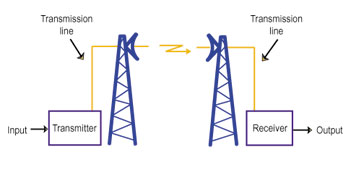

Microwave Link
A microwave link is a communications system that uses a beam of radio waves in the microwave frequency range to transmit information between two fixed locations on the earth. They are crucial to many forms of communication and impact a broad range of industries. Broadcasters use microwave links to send programs from the studio to the transmitter location, which might be miles away. Microwave links carry cellular telephone calls between cell sites. Wireless Internet service providers use microwave links to provide their clients with high-speed Internet access without the need for cable connections. Telephone companies transmit calls between switching centers over microwave links, although fairly recently they have been largely supplanted by fiber-optic cables. Companies and government agencies use them to provide communications networks between nearby facilities within an organization, such as a company with several buildings within a city.
One of the reasons microwave links are so adaptable is that they are broadband. That means they can move large amounts of information at high speeds. Another important quality of microwave links is that they require no equipment or facilities between the two terminal points, so installing a microwave link is often faster and less costly than a cable connection. Finally, they can be used almost anywhere, as long as the distance to be spanned is within the operating range of the equipment and there is clear path (that is, no solid obstacles) between the locations. Microwaves are also able to penetrate rain, fog, and snow, which means bad weather doesn’t disrupt transmission.

Satellite Internet access is Internet access provided through communications satellites. Modern satellite Internet service is typically provided to users through geostationary satellites that can offer high data speeds,[2] with newer satellites using Ka band to achieve downstream data speeds up to 50 Mbps.[3]
Satellite Internet generally relies on three primary components: a satellite in geostationary orbit (sometimes referred to as a geosynchronous Earth orbit, or GEO), a number of ground stations known as gateways that relay Internet data to and from the satellite via radio waves (microwave), and a VSAT (very-small-aperture terminal) dish antenna with a transceiver, located at the subscriber's premises. Other components of a satellite Internet system include a modem at the user end which links the user's network with the transceiver, and a centralized network operations center (NOC) for monitoring the entire system. Working in concert with a broadband gateway, the satellite operates a Star network topology where all network communication passes through the network's hub processor, which is at the center of the star. With this configuration, the number of remote VSATs that can be connected to the hub is virtually limitless.
Please contact us for details. One of our engineers will be happy to discuss your requirements.